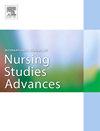Psychological distress and suicidal ideation in patients with depressive disorders: the chain mediation of psychological resilience and neuroticism
IF 3.1
Q1 NURSING
International Journal of Nursing Studies Advances
Pub Date : 2025-04-08
DOI:10.1016/j.ijnsa.2025.100325
引用次数: 0
Abstract
Objective
Suicide in depressed patients has become a serious challenge in the field of public health. In-depth analyses of the relationship between psychological distress and suicidal ideation, as well as its intrinsic mechanisms, are of great clinical significance for the prevention of suicide in depressed patients. The objective of this study was twofold: firstly, to explore the intrinsic relationship between psychological distress and suicidal ideation in depth; and secondly, to further investigate the mediating roles of psychological resilience and neuroticism in this relationship.
Methods
In this study, a cross-sectional research design was employed to select 200 patients diagnosed with depression from a mental health centre in Shandong Province. This study utilised the abbreviated version of the Big Five Personality Inventory, the Simplified Scale of Psychological Resilience, the Suicidal Ideation Scale, and the Kessler Psychological Distress Scale to administer questionnaires to patients.
Results
Psychological distress has a direct predictive effect on suicidal ideation. In depressed patients, it also exerts an indirect effect on suicidal ideation via three pathways: the separate mediating effect of psychological resilience, the separate mediating effect of neuroticism, and the chain mediating effect of psychological resilience and neuroticism.
Conclusion
In conclusion, the results of this study elucidate the effect of psychological distress on suicidal ideation in depressed patients and its mechanism of action. Furthermore, they demonstrate the chain-mediated roles of psychological resilience and neuroticism in the relationship between psychological distress and suicidal ideation in depressed patients. Finally, they provide a new perspective for understanding suicidal ideation and preventing suicidal risk in depressed patients. Nevertheless, the present study was only able to measure the correlation between the variables; therefore, it is not yet possible to infer causality. In future, more precise prediction and intervention programmes for suicide risk in depressed patients can be explored in depth through longitudinal or experimental studies, etc.
抑郁症患者的心理困扰与自杀意念:心理弹性与神经质的链式中介作用
目的抑郁症患者自杀已成为公共卫生领域面临的严峻挑战。深入分析心理困扰与自杀意念的关系及其内在机制,对预防抑郁症患者自杀具有重要的临床意义。本研究的目的有二:一是深入探讨心理困扰与自杀意念的内在关系;第二,进一步探讨心理弹性和神经质在这一关系中的中介作用。方法本研究采用横断面研究设计,选取山东省某精神卫生中心诊断为抑郁症的200例患者。本研究采用简化版大五人格量表、简易心理弹性量表、自杀意念量表和凯斯勒心理困扰量表对患者进行问卷调查。结果心理困扰对自杀意念有直接的预测作用。在抑郁症患者中,它还通过心理弹性的单独中介作用、神经质的单独中介作用以及心理弹性和神经质的连锁中介作用三种途径间接影响自杀意念。结论本研究结果阐明了心理困扰对抑郁症患者自杀意念的影响及其作用机制。此外,他们还证实了心理弹性和神经质在抑郁症患者心理困扰与自杀意念之间的链式中介作用。最后,它们为理解抑郁症患者的自杀意念和预防自杀风险提供了新的视角。然而,目前的研究只能测量变量之间的相关性;因此,还不可能推断出因果关系。未来可以通过纵向研究或实验研究等方式,对抑郁症患者自杀风险更精准的预测和干预方案进行深入探索。
本文章由计算机程序翻译,如有差异,请以英文原文为准。
求助全文
约1分钟内获得全文
求助全文
来源期刊

International Journal of Nursing Studies Advances
Nursing-General Nursing
CiteScore
5.80
自引率
0.00%
发文量
45
审稿时长
81 days
 求助内容:
求助内容: 应助结果提醒方式:
应助结果提醒方式:


